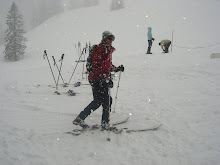It is well known high alpine areas are magnificent places to visit, work and even live in. Increased pressure from tourism and general infrastructure infringement place these fragile alpine ecosystems at risk. Mountain valley settlements are at risk of a variety of mountain disasters, including avalanches, torrents, rockfall and other erosion processes. Forests can serve a vital protective function in higher areas previously bare and susceptible to the extremes of the alpine environment.
These "protective forests" are typically managed to provide continuous and passive protection (P. Brang). When natural disturbances occur, the disturbances drastically affect how well a protective forest can function. I suppose it is worth elaborating a bit into the functions a protective forest can have, simply because they are often in place and we take them for granted. Forest soils in rugged mountain areas are often shallow and a forest keeps it in place. Precipitation is taken up and let out slowly, filtering the water for drinking, replenishing the ground water and preventing slope movement from occurring. Many alpine human habitats simply rely heavily on the stabilization characteristics that protective forests provide.
As lovely as protective forests seem, they are a fragile resource. Storms topple trees quickly, allowing a bark beetle outbreak to occur, threatening the surrounding trees and predisposing the area to develop an even larger gap. Avalanches and snow gliding may prevent trees from growing at all or severely crippling them. I will note that the alpine areas are very unforgiving to trees to begin with. A short growing season, cold temperatures and strong winds, and a long residual snow cover that breeds fungal pathogens all work hard against struggling tree seedlings.
We cannot change the climate occurrences, but we can help to maintain existing protective forests, promote new ones and construct measures for short-term hazard mitigation. Silvicultural practices to encourage the growth of seedlings, snow movement prevention and proper planting practices all help immensely. Most important of all, more people need to be educated on the widespread benefits of protective forests, including their risk mitigation abilities. What I would love to see is the designing of forests based on ecosystem function, like a forest designed for water filtration for instance. We could apply that concept to nearly any area...
Subscribe to:
Post Comments (Atom)

No comments:
Post a Comment